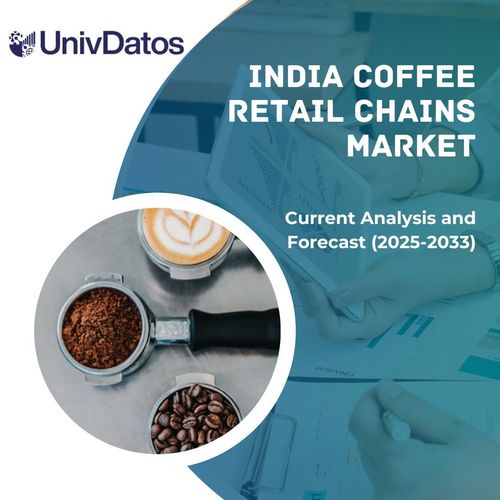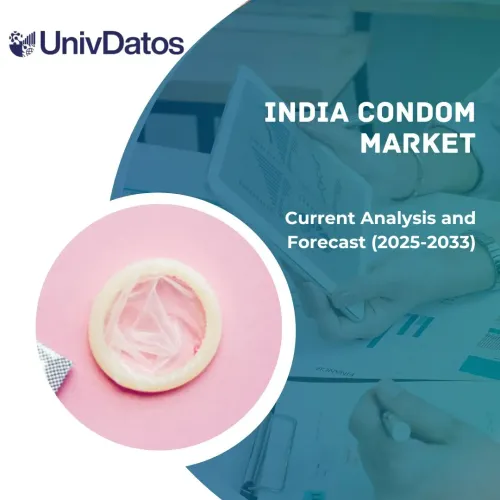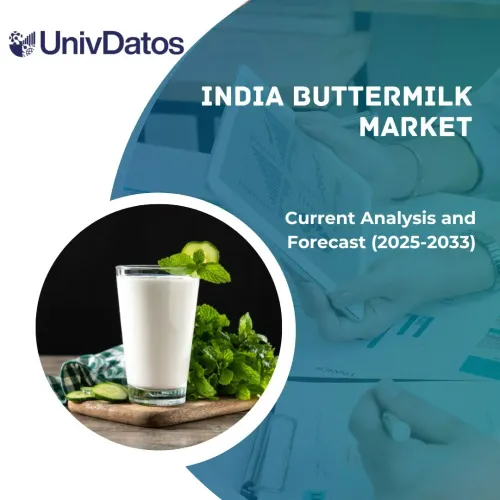- Home
- About Us
- Industry
- Services
- Reading
- Contact Us
Diabetic Food Market: Current Analysis and Forecast (2021-2027)
Emphasis on Product Type (Dietary Beverages, Bakery Products, Dairy Products, Confectionery Products, Ice Creams and Jellies, Others); Distribution Channel (Supermarkets & Hypermarket, Pharmacies, Grocery Stores, Online Stores, Others); End-User (Adults, Children); Region and Country
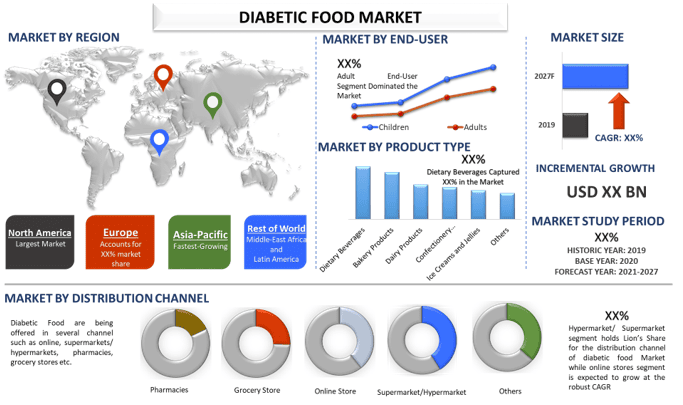
The global Diabetic Food Market is expected to display an elevated CAGR of ~5% over the forecast period (2021-2027).
A surge in the end user’s disposable income is one of the leading factors that is contributing to the growing market of Diabetic Food globally. Rising purchasing power in developing countries such as Australia, EU, Mexico, Brazil, India, Thailand, and China are projected to allow consumers to spend more on ready-made food and partying outside, which is also acting as a growth catalyst to the industry. As per OCED, the household spending in Canada, China, Denmark, European Union, France, and Germany reached to 1,021,459.5, 9,241,095.5, 139,229.8, 10,785,281.3, 1,561,879.9 and 2,288,541.1 US$ million, respectively. Also, the rising purchasing power is leading to the growing investment in several food products including Diabetic Food, etc., which is contributing to the growing market for Diabetic Food.
The rising prevalence of diabetes owing to the adoption of a sedentary lifestyle and eating habits is one of the key factors which is resulting in the demand for diabetic food. As per the International Diabetes Federation, the number of adults with diabetes would reach 63 million by 2045, an up of 33% from 48 million in 2019. Also, A rise in disposable income coupled with the availability of Diabetic Food at reasonable prices and rising demand from men are some of the factors that are contributing to the growth of the market. As per OCED, the household disposable income in Canada increased from 2.1% in 2019 to 7.3% in 2020.
Also, As per the Center for Disease Control and Prevention (CDC), 34.2 million people have diabetes (10.5% of the US population) and 26.9 million people, including 26.8 million adults. Moreover, around 88 million people aged 18 years or older have prediabetes (34.5% of the adult US population) as of 2020.
Estimated Number Of Adults With Diabetes (In Millions), 2000-2045F
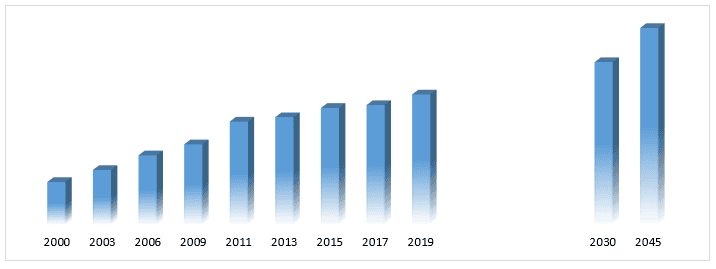
Nestlé, Unilever, THE COCA-COLA COMPANY, PepsiCo, Kellogg NA Co., Fifty50 Foods, Mondelēz International, Zen Health, Anhui Elite Industrial Co., ltd, TFI Holdings, Mars Incorporated, etc., are some of the prominent players operating in the Diabetic Food market. Several M&As along with partnerships have been undertaken by these players to facilitate customers with hi-tech and innovative products.
Insights Presented in the Report
“Amongst Product Type, Dietary Beverages segment holds the major share”
Based on the Product Type, the market is fragmented into Dietary Beverages, Bakery Products, Dairy Products, Confectionery Products, Ice cream and Jellies, and Others. The Dietary Beverages segment grabbed the major market share in 20202 and dominated the market. Moreover, the market of this segment is expected to witness an exhibit growth during the forthcoming years due to the rising awareness among consumers. However, the confectionery products would witness a considerable CAGR owing to the rising popularity among millenniums
“Amongst Distribution Channel, hypermarket/ supermarket segment to dominate the market during the forecast period”
Based on the Distribution Channel the market is fragmented into Supermarkets and hypermarkets, Pharmacies, Grocery Stores, Online Stores, and Others. The hypermarket/ supermarket segment captured XX% market share in the Diabetic Food Market in 2020 and dominated the market. Moreover, the market would witness a sharp rise in the forthcoming years owing to the surging number of hypermarkets/ supermarkets. Also, the availability of several brands under one roof is leading to the growth of this segment. However, the online segment would witness sky-rocked growth in the forecast period of 2021-2027F
“Amongst End-User, Adults segment to dominate the market during the forecast period”
Based on the end-user, the market is fragmented into Children and Adults. The adults’ segment captured XX% market share in the Diabetic Food Market in 2020 and dominated the market. Moreover, the market would witness a sharp rise in the forthcoming years owing to the rising number of adults with diabetes.
“North America represents one of the largest markets of Diabetic Food market”
For a better understanding of the market dynamics of the Diabetic Food market, a detailed analysis was conducted for different regions across the globe including North America, Europe, Asia Pacific, and the Rest of the world. North America dominated the market and generated the leading revenue share in 2020 owing to the rise in disposable income coupled with the availability of Diabetic Food at reasonable prices and rising demand from men are some of the factors that are contributing to the growth of the market. As per OCED, the household disposable income in Canada increased from 2.1% in 2019 to 7.3% in 2020.
Reasons to buy this report:
- The study includes market sizing and forecasting analysis validated by authenticated key industry experts
- The report presents a quick review of overall industry performance at one glance
- The report covers an in-depth analysis of prominent industry peers with a primary focus on key business financials, product portfolio, expansion strategies, and recent developments
- Detailed examination of drivers, restraints, key trends, and opportunities prevailing in the industry
- The study comprehensively covers the market across different segments
- Deep dive regional level analysis of the industry
Customization Options:
The Diabetic Food Market can further be customized as per the requirement or any other market segment. Besides this, UMI understands that you may have your own business needs, hence feel free to connect with us to get a report that completely suits your requirements.
Table of Content
Analyzing the historical market, estimation of the current market, and forecasting the future market of the Diabetic Food Market were the three major steps undertaken to create and analyze the demand for Diabetic Food across major regions. Exhaustive secondary research was conducted to collect the historical market numbers and estimate the current market size. Secondly, to validate these insights, numerous findings and assumptions were taken into consideration. Moreover, exhaustive primary interviews were also conducted, with industry experts across the value chain of the Diabetic Food market. Post assumption and validation of market numbers through primary interviews, we employed a top-down/ bottom-up approach to forecast the complete market size. Thereafter, market breakdown and data triangulation methods were adopted to estimate and analyze the market size of segments and sub-segments the industry pertains to. Detailed methodology is explained below:
Analysis of Historical Market Size
Step 1: In-Depth Study of Secondary Sources:
Detailed secondary study was conducted to obtain the historical market size of the Diabetic Food through company internal sources such as annual reports & financial statements, performance presentations, press releases, etc., and external sources including journals, news & articles, government publications, competitor publications, sector reports, third-party database, and other credible publications.
Step 2: Market Segmentation:
After obtaining the historical market size of the Diabetic Food market, we conducted a detailed secondary analysis to gather historical market insights and share for product type, distribution channel, end-user for major regions. Major segments included in the report are product type and material. Further region and country-level analyses were conducted to evaluate the overall adoption of Diabetic Food across the globe.
Step 3: Factor Analysis:
After acquiring the historical market size of different segments and sub-segments, we conducted a detailed factor analysis to estimate the current market size of Diabetic Food. Further, we conducted factor analysis using dependent and independent variables such as growth in the disposable income, rising aging population, and emerging number diabetes patients, etc., A thorough analysis was conducted for demand and supply-side scenarios considering top partnerships, merger and acquisition, business expansion, and product launches in the Diabetic Food industry across the globe.
Current Market Size Estimate & Forecast
Current Market Sizing: Based on actionable insights from the above 3 steps, we arrived at the current market size, key players in the Diabetic Food market, and market shares of the segments. All the required percentage shares split, and market breakdowns were determined using the above-mentioned secondary approach and were verified through primary interviews.
Estimation & Forecasting: For market estimation and forecast, weightage was assigned to different factors including drivers & trends, restraints, and opportunities available for the stakeholders. After analyzing these factors, relevant forecasting techniques i.e. bottom-up/ top-down approach was applied to arrive at the market forecast about 2027 for different segments and subsegments across the major markets globally. The research methodology adopted to estimate the market size encompasses:
- The industry’s market size, in terms of value (US$) and the adoption rate of Diabetic Food across the major markets domestically
- All percentage shares, splits, and breakdowns of market segments and sub-segments
- Key players in the Diabetic Food market in terms of services offered. Also, the growth strategies adopted by these players to compete in the fast-growing market
Market Size and Share Validation
Primary Research: In-depth interviews were conducted with the Key Opinion Leaders (KOLs) including Top Level Executives (CXO/VPs, Sales Head, Marketing Head, Operational Head, and Regional Head, Country Head, etc.) across major regions. Primary research findings were then summarized, and statistical analysis was performed to prove the stated hypothesis. Inputs from primary research were consolidated with secondary findings, hence turning information into actionable insights.
Split of Primary Participants in Different Regions
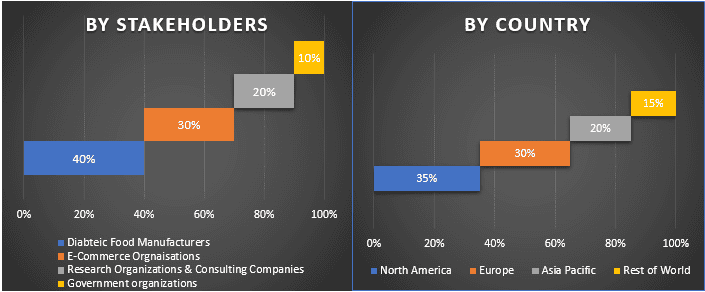
Market Engineering
Data triangulation technique was employed to complete the overall market estimation and to arrive at precise statistical numbers of each segment and sub-segment of the Diabetic Food market. Data was split into several segments sub-segments post studying various parameters and trends in the areas of product type, distribution channel, end-user of the Diabetic Food market.
Main Objective of the Diabetic Food Market Study
The current & future market trends of Diabetic Food were pinpointed in the study. Investors can gain strategic insights to base their discretion for investments from the qualitative and quantitative analysis performed in the study. Current and future market trends were determined the overall attractiveness of the market at a regional level, providing a platform for the industrial participant to exploit the untapped market to benefit as a first-mover advantage. Other quantitative goals of the studies include:
- Analyze the current and forecast market size of Diabetic Food in terms of value (US$). Also, analyze the current and forecast market size of different segments and sub-segments
- Segments in the study include areas of product type, distribution channel, end-user
- Define and analysis of the regulatory framework for the Diabetic Food industry
- Analyze the value chain involved with the presence of various intermediaries, along with analyzing customer and competitor behaviors of the industry
- Analyze the current and forecast market size of the Diabetic Food market for the major countries
- The major region studied in the report includes North America, Europe, Asia- Pacific, and the Rest of the World.
- Company profiles of the Diabetic Food market and the growth strategies adopted by the market players to sustain in the fast-growing market
- Deep dive regional level analysis of the industry
Related Reports
Customers who bought this item also bought




